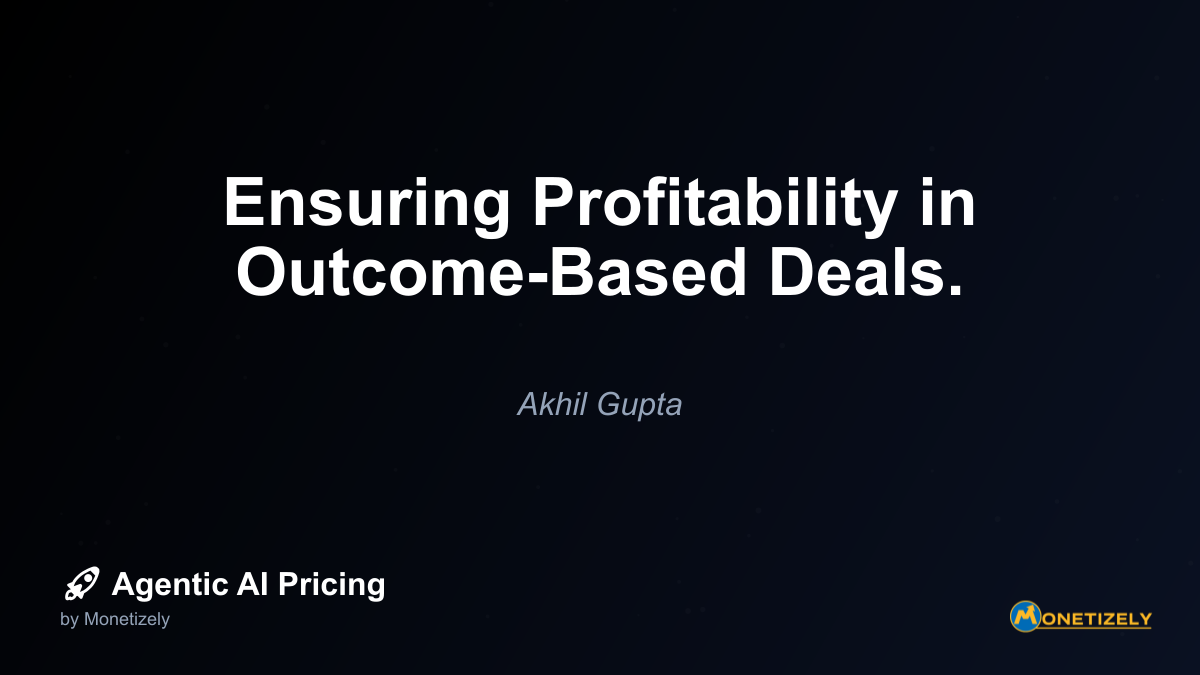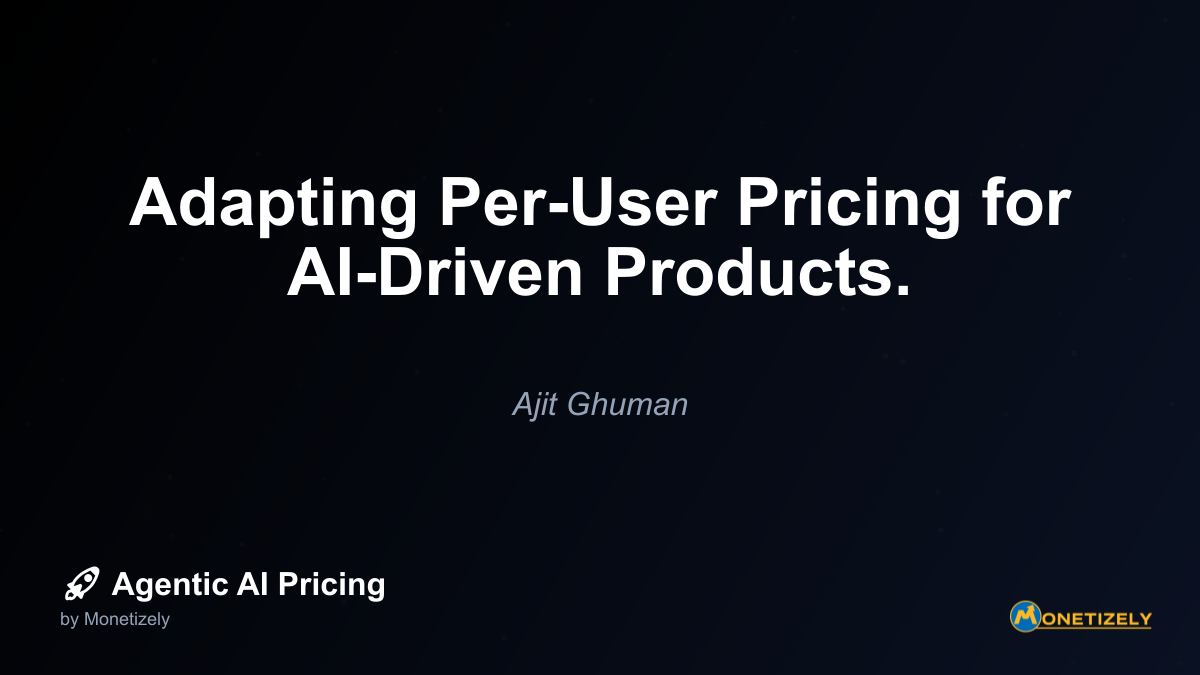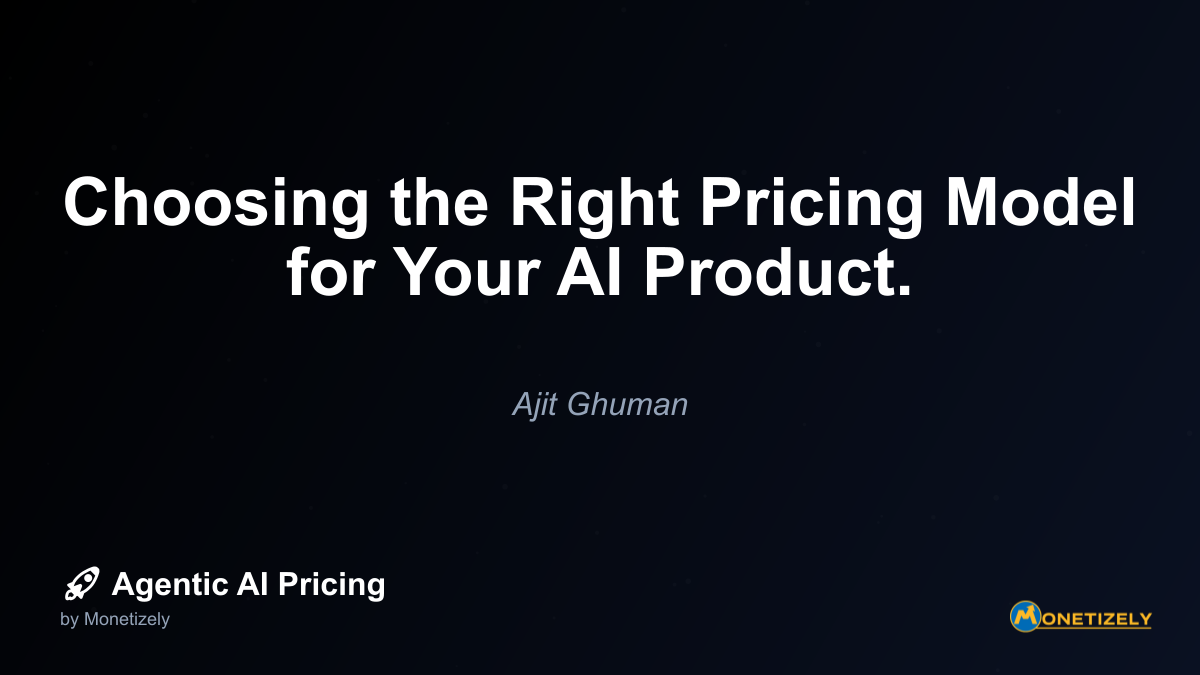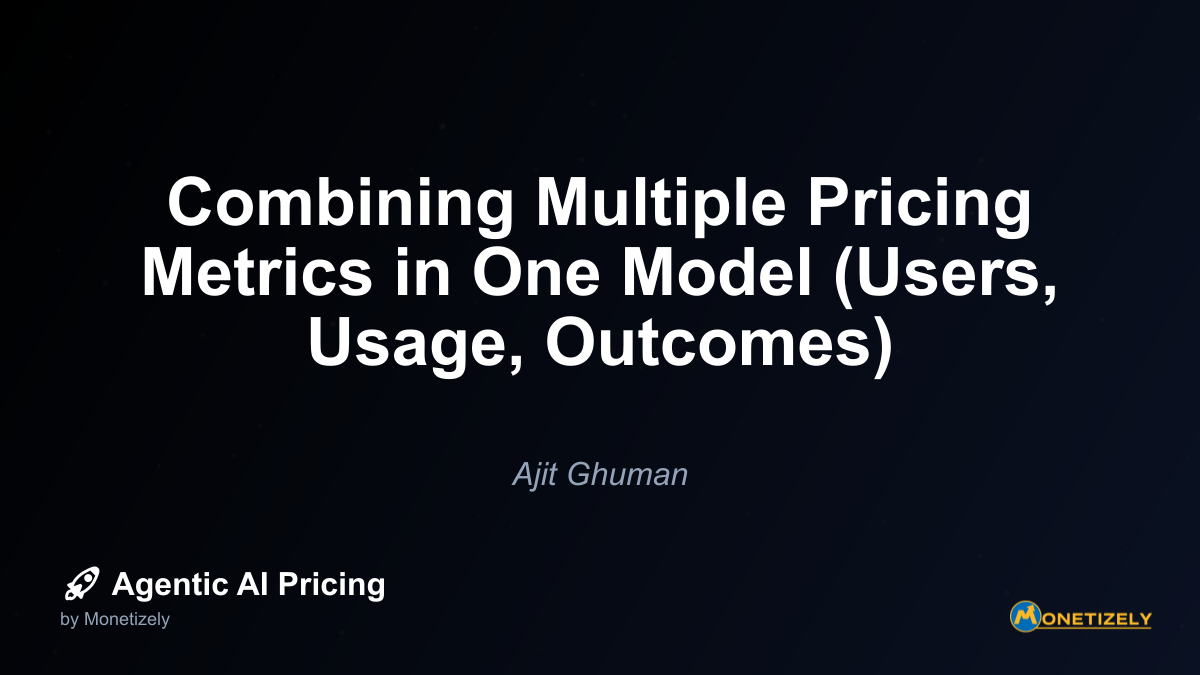· Ajit Ghuman · Agentic AI Pricing Strategies · 13 min read
Outcome-Based Pricing: Only Paying for Results.
AI and SaaS Pricing Masterclass
Learn the art of strategic pricing directly from industry experts. Our comprehensive course provides frameworks and methodologies for optimizing your pricing strategy in the evolving AI landscape. Earn a professional certification that can be imported directly to your LinkedIn profile.
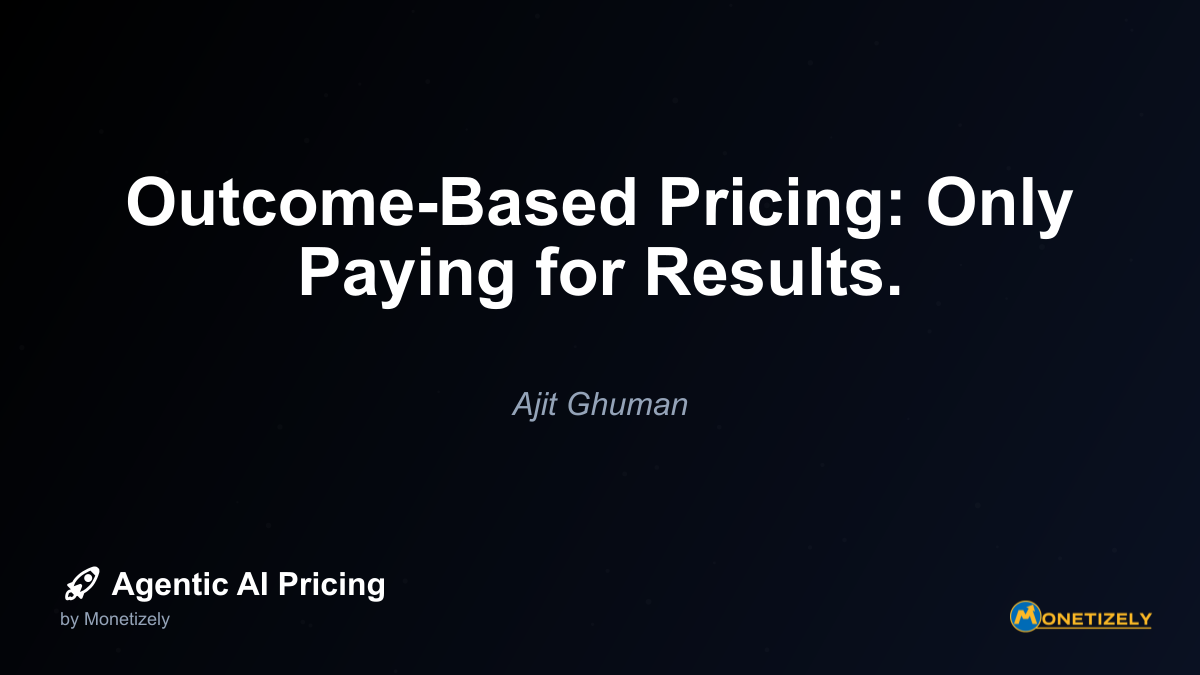
In today’s rapidly evolving AI landscape, pricing models are becoming as sophisticated as the technologies they support. Among these emerging approaches, outcome-based pricing stands out as perhaps the most aligned with the fundamental promise of artificial intelligence: delivering measurable business results. This pricing paradigm represents a significant shift from traditional models by directly linking payment to the achievement of specific, predefined business outcomes.
The Fundamental Shift: From Access to Results
Traditional software pricing models have historically centered around access—whether through perpetual licenses, subscription fees, or consumption-based models. Customers pay for the right to use a product or service, regardless of the results they achieve. But as AI solutions mature and their capabilities expand, both vendors and customers are questioning this disconnect between cost and value.
Outcome-based pricing fundamentally rewires this relationship. Under this model, customers pay only when the AI solution delivers specific, measurable business outcomes—such as cost savings, revenue generation, or efficiency improvements. This approach creates a powerful alignment of incentives, where vendors succeed only when their customers do.
As one Boston Consulting Group report notes, “Software vendors must carefully navigate packaging AI features and transitioning their pricing models to outcome-based approaches without risking revenue loss. Success depends on defining agent capabilities clearly and aligning prices with realized business value.”
How Outcome-Based Pricing Works in Practice
The implementation of outcome-based pricing requires careful planning and clear definitions. Here’s how it typically works:
Define measurable outcomes: Vendor and customer collaborate to identify specific, quantifiable business results that will trigger payment.
Establish measurement methodology: Both parties agree on how outcomes will be tracked, measured, and validated.
Set pricing structure: Payment terms are established based on achieved outcomes, often capturing 25-50% of the created value.
Monitor and report: Sophisticated tracking systems continuously measure performance against defined metrics.
Bill based on results: Invoicing occurs only when agreed-upon outcomes are achieved.
Several pioneering companies have already implemented outcome-based pricing for their AI solutions:
Intercom, a customer support AI provider, charges $0.99 per successful resolution delivered by its AI chatbot “Fin.” Customers pay only when a support issue is successfully resolved by AI, ensuring that billing is based on tangible customer service outcomes rather than flat fees or usage metrics.
Zendesk has implemented outcome-based pricing linked to AI agent performance, charging customers only for issues resolved autonomously by AI agents. Their plan incorporates baseline free automated resolutions, and customers can monitor and cap usage. The pricing reflects the transformation in customer experience driven by AI and emphasizes value from automated resolution of customer issues without human intervention.
The Business Case for Outcome-Based Pricing
For Customers
Outcome-based pricing offers several compelling advantages for AI solution buyers:
Reduced risk: With payment contingent on results, customers minimize the risk of investing in solutions that don’t deliver value. This is particularly important for AI technologies, where promises sometimes outpace performance.
Better ROI clarity: By directly linking cost to specific business outcomes, customers gain unprecedented transparency into their return on investment.
Stronger vendor accountability: Vendors are incentivized to ensure their solutions deliver measurable results, leading to stronger performance and ongoing optimization.
Improved budget justification: When payments are tied directly to outcomes, it becomes easier to justify technology investments to financial stakeholders.
For Vendors
While outcome-based pricing may seem to shift risk to vendors, it offers several strategic advantages:
Higher revenue potential: By capturing a percentage of delivered value (typically 25-50%), vendors can potentially earn more than with traditional pricing models that capture only 10-20% of created value.
Competitive differentiation: Offering outcome-based pricing signals confidence in solution effectiveness and can differentiate vendors in crowded markets.
Stronger customer relationships: Aligning incentives with customer success fosters deeper partnerships and improves satisfaction by 27-31% compared to traditional models.
Focused innovation: Development priorities naturally align with creating features that deliver measurable customer value.
Challenges and Implementation Considerations
Despite its advantages, outcome-based pricing presents significant challenges that must be carefully managed:
1. Defining and Measuring Outcomes
Perhaps the most fundamental challenge is clearly defining what constitutes a successful outcome. This requires:
- Establishing unambiguous definitions of success metrics
- Creating reliable measurement methodologies
- Ensuring both parties agree on how outcomes are tracked and verified
- Accounting for external factors that may influence results
According to research from Andreessen Horowitz, nearly half of buyers struggle with outcome definition, representing a significant adoption barrier. This challenge is particularly acute in complex domains where multiple factors influence results.
2. Technical Infrastructure Requirements
Implementing outcome-based pricing demands robust technical infrastructure:
- Real-time performance monitoring systems
- Secure data collection and analysis capabilities
- Integration with customer systems to track relevant metrics
- Transparent reporting mechanisms accessible to both parties
Without these technical foundations, disputes over performance and billing become inevitable, undermining the trust that outcome-based pricing aims to build.
3. Financial Risk Management
For vendors, outcome-based pricing shifts financial risk from customers to providers. Managing this risk requires:
- Careful financial modeling to ensure sustainability
- Understanding the probability of achieving different outcome levels
- Potentially implementing hybrid models that combine outcome-based elements with more predictable revenue streams
- Developing contingency plans for underperforming implementations
4. Contractual Complexity
Outcome-based pricing agreements are inherently more complex than traditional licenses or subscriptions:
- Contracts must precisely define outcomes, measurement methodologies, and payment terms
- Dispute resolution mechanisms must be established for disagreements about performance
- Governance structures are needed to manage ongoing relationship and measurement issues
- Clear terms around data access, privacy, and security become critical
Industries Where Outcome-Based Pricing Excels
While outcome-based pricing can theoretically apply to any AI implementation, certain industries and use cases are particularly well-suited to this approach:
Customer Support and Service
AI-powered customer support offers clear, measurable outcomes such as tickets resolved without human intervention. Companies like Intercom and Zendesk have successfully implemented outcome-based pricing in this domain, charging only for successful autonomous resolutions.
Sales and Marketing
AI solutions for lead generation, qualification, and conversion lend themselves to outcome-based pricing. One AI sales development company transitioned from charging per lead generated to charging per qualified sales opportunity, directly reflecting the value created.
Financial Services
In financial services, outcomes like fraud prevention, chargeback dispute resolution, or automated underwriting decisions provide clear metrics for outcome-based pricing. The direct financial impact of these outcomes makes value calculation straightforward.
Supply Chain and Logistics
AI-driven optimization in supply chains offers measurable efficiency improvements, cost reductions, and performance enhancements that can be directly linked to payment structures.
Industries Facing Greater Challenges with Outcome-Based Pricing
Conversely, some industries face particular challenges in implementing outcome-based pricing:
Healthcare and Life Sciences
Healthcare outcomes are influenced by numerous variables beyond AI intervention, making attribution complex. Additionally, regulatory and ethical considerations can complicate outcome-based pricing structures.
Creative and Consultative Services
When AI assists with creative or consultative work, outcomes tend to be more subjective and qualitative, making them difficult to measure and price based on results.
Complex Manufacturing
In complex manufacturing environments, multiple factors influence outcomes, and AI may be just one component of a larger system, complicating attribution of results specifically to AI interventions.
Best Practices for Implementing Outcome-Based Pricing
Organizations considering outcome-based pricing for AI solutions should follow these best practices:
1. Start with Clear Definitions and Metrics
Before implementing outcome-based pricing, both vendors and customers must agree on:
- Precise definitions of what constitutes a successful outcome
- Specific metrics that will be tracked and how they relate to business value
- Attribution methodology to determine when outcomes are directly linked to AI intervention
- Baseline performance levels against which improvements will be measured
2. Implement Robust Measurement Systems
Reliable, transparent measurement is the foundation of successful outcome-based pricing:
- Deploy automated tracking systems that capture relevant metrics in real-time
- Ensure both parties have access to performance data
- Establish audit protocols to verify measurement accuracy
- Consider third-party validation for particularly critical or contentious metrics
3. Consider Hybrid Approaches
Pure outcome-based pricing may not be suitable for all situations. Hybrid models can balance risk and predictability:
- Combine baseline subscription fees with outcome-based components
- Implement tiered pricing based on outcome thresholds
- Include caps or floors to manage financial risk for both parties
- Scale outcome-based elements as confidence in measurement increases
4. Develop Clear Governance and Dispute Resolution
Even with careful planning, disagreements about performance and payment may arise:
- Establish joint governance committees to oversee implementation
- Define clear escalation paths for resolving disputes
- Consider third-party arbitration for unresolved disagreements
- Create regular review cycles to refine definitions and measurements
5. Start with Pilot Programs
Before full implementation, consider limited-scope pilots:
- Test outcome-based pricing with a subset of functionality or customers
- Use pilots to refine measurement methodologies and definitions
- Gather data on actual performance to inform broader rollout
- Build confidence in the approach before full-scale implementation
The Future of Outcome-Based Pricing for AI
As AI continues to mature and deliver increasingly sophisticated capabilities, outcome-based pricing is poised for significant growth. Several trends will shape its evolution:
AI-Powered Measurement and Optimization
Ironically, AI itself will enable more sophisticated outcome-based pricing by:
- Automating complex measurement processes
- Identifying causal relationships between AI interventions and business outcomes
- Optimizing AI performance to maximize measured outcomes
- Providing transparent reporting and predictive analytics on likely results
Standardization of Outcome Definitions
As outcome-based pricing becomes more common, expect to see:
- Industry-standard definitions for common outcomes across sectors
- Benchmarking data to establish reasonable performance expectations
- Certification programs for outcome measurement methodologies
- Best practice frameworks for implementing outcome-based pricing
Evolution of Hybrid Models
The binary distinction between traditional and outcome-based pricing will blur:
- More sophisticated hybrid models combining elements of multiple approaches
- Dynamic pricing that adjusts based on achieved outcomes and changing conditions
- Portfolio approaches where different components of a solution use different pricing models
- Risk-sharing arrangements that distribute upside and downside between vendors and customers
Regulatory and Ethical Considerations
As outcome-based pricing becomes more prevalent, expect increased attention to:
- Data privacy implications of extensive outcome tracking
- Potential for gaming or manipulation of outcome metrics
- Fairness considerations in how outcomes are defined and measured
- Transparency requirements for outcome-based pricing agreements
Case Study: Zendesk’s Outcome-Based Pricing Implementation
Zendesk’s implementation of outcome-based pricing for its AI agents provides a compelling example of this approach in action. In 2024, Zendesk shifted from traditional seat-license and token-based pricing to an outcome-based model charging customers only for issues AI agents successfully resolve autonomously.
Key elements of their implementation include:
- Clear outcome definition: Payment is triggered only when customer issues are fully resolved without human intervention.
- Baseline free tier: A certain number of automated resolutions are included at no cost.
- Usage monitoring and caps: Customers can track usage and set limits to control costs.
- Hybrid approach: Flexibility to combine AI and human agents within the same system.
This approach aligns Zendesk’s revenue directly with the value delivered—autonomous resolution of customer issues—rather than charging for access to the technology regardless of results.
Case Study: The Challenges of Attribution in AI Sales Development
An AI sales development company highlighted by Boston Consulting Group demonstrates both the potential and challenges of outcome-based pricing. Initially, the company charged per lead generated, email sent, and AI seat, but customers felt the cost did not correlate well with actual sales outcomes.
In response, the company began transitioning to a pay-for-performance model charging per qualified sales opportunity. However, this transition revealed several challenges:
- Attribution complexity: Determining when an opportunity was truly qualified and attributable to the AI system required careful definition.
- Measurement infrastructure: New systems were needed to track opportunities through the sales pipeline.
- Risk management: The company needed to balance the uncertainty of outcome-based revenue with financial stability.
This case illustrates how outcome-based pricing, while conceptually appealing, requires careful implementation and may need to evolve over time as both vendors and customers learn from experience.
Ethical and Regulatory Considerations
Implementing outcome-based pricing for AI solutions raises important ethical and regulatory considerations:
Data Access and Privacy
Measuring outcomes often requires access to sensitive business data:
- Clear data governance frameworks must establish what data can be accessed and how it will be used
- Privacy regulations like GDPR and CCPA create compliance requirements for outcome tracking
- Data minimization principles should guide what information is collected for measurement
Transparency and Fairness
Outcome-based pricing must be implemented transparently:
- Customers should fully understand how outcomes are defined and measured
- Pricing should fairly reflect the value delivered without exploiting information asymmetries
- Both parties should have equal access to performance data
Bias and Algorithmic Fairness
AI systems themselves may exhibit biases that affect outcome measurement:
- Outcome definitions should be designed to avoid reinforcing or amplifying existing biases
- Regular auditing should ensure fair performance across different customer segments
- Transparency about how AI makes decisions is essential for fair outcome attribution
ROI Calculation for Outcome-Based Pricing
One of the most compelling aspects of outcome-based pricing is the clarity it provides for return on investment calculations. Unlike traditional models where ROI must be calculated separately from pricing, outcome-based approaches directly link the two.
Key components of ROI calculation in outcome-based pricing include:
1. Hard Savings
Direct cost reductions attributable to AI implementation, such as:
- Reduced labor costs through automation
- Decreased vendor expenses
- Elimination of redundant systems
2. Revenue Uplift
Increased revenue directly attributable to AI intervention:
- Additional sales generated
- Improved conversion rates
- Enhanced customer retention
3. Efficiency Gains
Productivity improvements that create business value:
- Reduced time to complete processes
- Increased throughput
- Improved resource utilization
4. Risk Reduction
Value created through reduced business risk:
- Decreased fraud or error rates
- Improved compliance
- Enhanced security
By agreeing on these value components upfront, vendors and customers create a framework for measuring and sharing the value created by AI implementations.
Comparing Pricing Models for AI Solutions
To fully understand the advantages and challenges of outcome-based pricing, it’s helpful to compare it with other common AI pricing models:
Subscription Model
Description: Customers pay a recurring fee for access to AI services.
Advantages:
- Predictable revenue for vendors
- Simple budgeting for customers
- Easy to understand and implement
Disadvantages:
- Disconnected from actual value delivered
- No incentive for vendors to ensure outcomes
- Customers pay regardless of results
Example: Most SaaS AI platforms like Salesforce Einstein or IBM Watson offer subscription tiers.
Usage-Based Model
Description: Charges are based on the amount of AI resources used (API calls, processing time, etc.).
Advantages:
- Aligns cost with utilization
- Scalable as needs grow
- Transparent connection between usage and cost
Disadvantages:
- Can lead to unpredictable costs
- Usage doesn’t necessarily correlate with value
- May discourage experimentation
Example: OpenAI’s GPT models charge based on tokens processed.
Hybrid Model
Description: Combines elements of subscription and usage-based models.
Advantages:
- Balances predictability with alignment to usage
- Can be tailored to specific customer needs
- Provides some cost control while allowing scaling
Disadvantages:
- More complex to understand and manage
- Still not directly tied to business outcomes
- May create conflicting incentives
Example: Many cloud AI services offer base subscriptions with usage-based components.
Outcome-Based Model
Description: Payment is tied directly to the outcomes achieved by AI solutions.
Advantages:
- Directly aligns vendor and customer incentives
- Minimizes risk for customers
- Creates clear ROI visibility
- Encourages vendor focus on customer success
Disadvantages:
- Complex to define and measure outcomes
- Requires sophisticated tracking infrastructure
- May create unpredictable revenue for vendors
- Can lead to disputes over attribution
Example: Zendesk charging only for customer issues resolved autonomously by AI.
Implementing Outcome-Based Pricing: A Strategic Framework
For organizations considering outcome-based pricing for their AI solutions, the following strategic framework provides a structured approach:
Phase 1: Assessment and Planning
Value identification: Define the specific business outcomes the AI solution can deliver and quantify their value.
Measurement feasibility: Assess whether outcomes can be reliably measured and attributed to AI intervention.
Risk analysis: Evaluate the financial implications and risks for both vendor and customer.
Stakeholder alignment: Ensure all stakeholders understand and support the outcome-based approach.
Phase 2: Design and Definition
Outcome specification: Clearly define what constitutes a successful outcome, including all relevant metrics and thresholds.
Measurement methodology: Design the technical and procedural approach to measuring outcomes.
Pricing structure: Develop the pricing model, including how payments relate to outcomes and any hybrid elements.
Governance framework: Establish processes for ongoing management, dispute resolution, and performance review.
Phase 3: Implementation and Infrastructure
Measurement systems: Deploy the technical infrastructure needed to track and report on outcomes.
Data integration: Connect to relevant customer systems to capture necessary performance data.
Reporting dashboards: Create transparent reporting tools accessible to both vendor
Co-Founder & CEO
Ajit is the author of Price To Scale, a top book on SaaS Pricing and is the Founder of Monetizely. Ajit has led and worked in pricing and product marketing at firms like Twilio, Narvar and Medallia. His work has been featured in Forbes and VentureBeat. Ajit regularly consults with software companies from Seed stage to post-IPO on pricing strategy. Ajit is also a highly-rated co-instructor for 'The Art of SaaS Pricing and Monetization' on Maven.
Pricing Strategy Audit
Let our experts analyze your current pricing strategy and identify opportunities for improvement. Our data-driven assessment will help you unlock untapped revenue potential and optimize your AI pricing approach.

